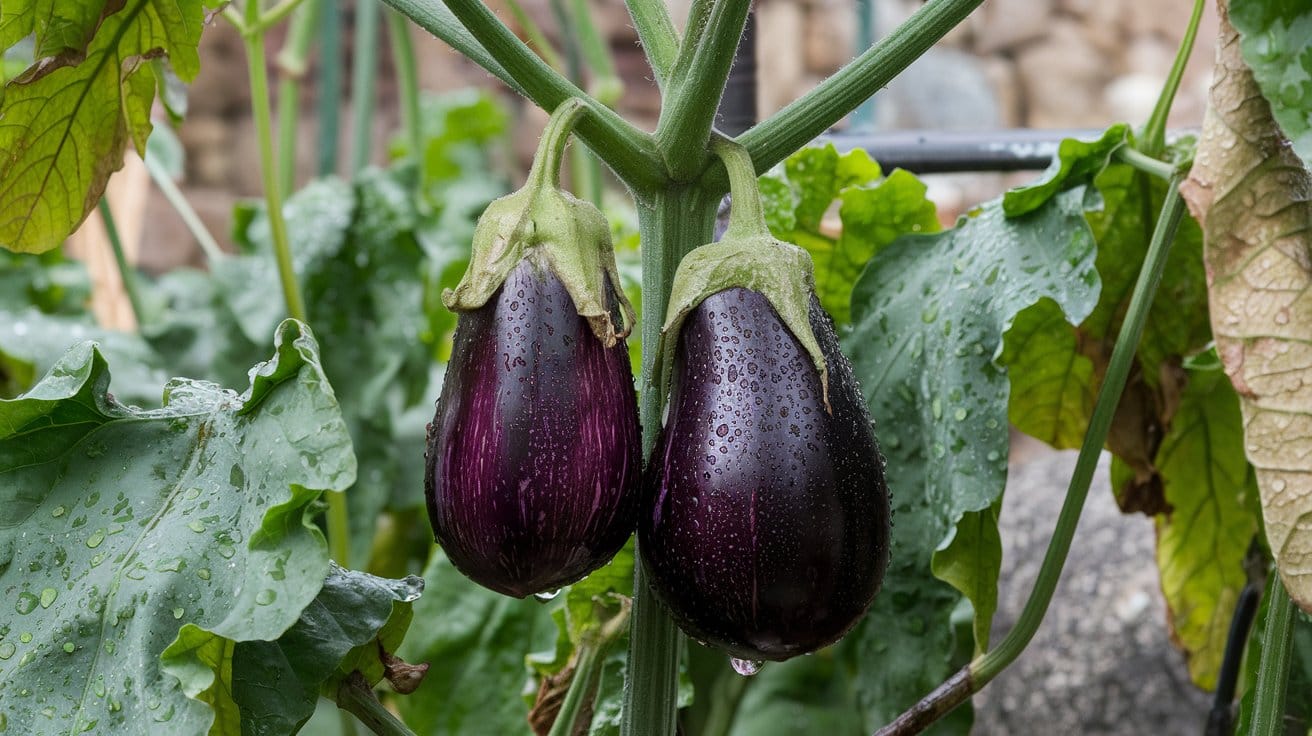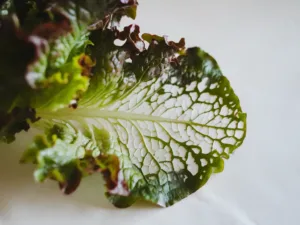Eggplants – these glossy, deep purple fruits are a staple in many international cuisines. Whether in a spicy ratatouille, crispy slices in a parmigiana, or grilled as a side dish, eggplants are versatile and rich in flavor. But did you know they are also perfect for hydroponic cultivation? Growing eggplants in a hydroponic system not only allows you to cultivate these delicious fruits yourself but also enjoy a fresh harvest year-round.
Hydroponics, the cultivation of plants in a nutrient-rich water solution without soil, offers numerous advantages. Especially in urban areas where space is limited, hobbyists and professionals can grow eggplants in vertical systems or small indoor spaces. By controlling water, nutrients, and light, you can create an optimal environment for growth. As a result, eggplants grow faster, stronger, and are less prone to diseases. Let’s dive into the world of hydroponic eggplants and discover how you can successfully grow these magnificent fruits in your own system.
Variety Selection: The Best Eggplant Varieties for Hydroponics
Not all eggplant varieties are equally suited for hydroponic cultivation. Choosing the right variety can make the difference between a sparse harvest and an abundant yield. There are several criteria to consider when selecting the right eggplant variety: growth habit, fruit size, color, and disease resistance. By paying attention to these aspects, you can select the best varieties for your system.
- Compact Varieties for Limited Spaces: If you have limited space or use a compact hydroponic system, smaller eggplant varieties like “Little Finger” are ideal. This variety is known for its slender, finger-shaped fruits that grow quickly and have a tender, mild flavor. Another excellent choice is “Patio Baby,” a dwarf variety that produces small, deep purple fruits and is perfect for small systems or balconies.
- Large Varieties for Bigger Systems: If you use a larger system like Deep Water Culture (DWC) or an ebb-and-flow system, you can also grow larger varieties like the classic “Black Beauty” or “Rosa Bianca.” “Black Beauty” is known for its deep purple, pear-shaped fruits with a rich, full-bodied flavor. “Rosa Bianca,” on the other hand, is an Italian heirloom variety with white-pink striped fruits and a mild, creamy taste.
- Resistant Varieties for Indoor Growing: For indoor cultivation or in regions where certain plant diseases are common, resistant varieties are particularly valuable. The “Millionaire” variety is a Japanese eggplant known for its elongated, glossy purple fruits and is more resistant to diseases like powdery mildew and Verticillium wilt.
No matter which variety you choose, each has its unique advantages. Remember that a variety that thrives in one system may not yield the same results in another. Therefore, make sure to adjust your variety selection to your hydroponic setup and available space.
Suitable Hydroponic Systems for Eggplants
The success of your eggplant cultivation depends not only on the choice of variety but also on selecting the right hydroponic system. Different systems offer different advantages, and it’s important to choose the one that best meets your plants’ needs.
- Deep Water Culture (DWC): This system is excellent for larger eggplant varieties like “Black Beauty.” The plant roots are constantly submerged in an aerated nutrient solution, ensuring a continuous supply of water and nutrients. DWC systems offer the advantage of being relatively easy to maintain and create a stable growth environment, particularly beneficial for robust plants like eggplants.
- Nutrient Film Technique (NFT): NFT systems are ideal for smaller eggplant varieties like “Little Finger” or “Patio Baby.” In this system, a thin layer of nutrient solution flows over the roots, providing good oxygen supply while reducing water consumption. NFT systems are particularly advantageous in confined spaces or for vertical growing systems.
- Ebb and Flow System: These systems are versatile and can support both small and larger eggplant varieties. The ebb and flow system periodically floods the root bed with nutrients and then drains it, ensuring good oxygen supply to the roots. It’s a good choice if you want to grow a mix of different eggplant varieties in a single system.
By choosing the right system, you can ensure that your eggplants grow and thrive under optimal conditions. Remember that each system has its own requirements, and you must adapt your growing techniques accordingly.
Optimal Lighting for Strong Eggplant Plants
Light is one of the most important resources for eggplant growth, especially when growing them in an indoor hydroponic system. Eggplants need plenty of light to grow healthily and achieve good fruiting. Therefore, proper lighting is crucial.
- Light Intensity and Duration: Eggplants require about 12-16 hours of light per day to grow optimally. High light intensity promotes photosynthesis and helps plants develop strong roots, leaves, and fruits. LED grow lights are an excellent choice for indoor cultivation as they are energy-efficient and provide a full light spectrum necessary for eggplant growth.
- Lamp Placement and Orientation: The positioning of the lamps is crucial to ensure that the eggplant plants are evenly illuminated. Keep the lamps about 30-45 cm above the plants to maximize light intensity without burning the leaves. As the plants grow, adjust the height of the lamps accordingly to maintain the proper distance. Use reflective surfaces or specialized grow lights with reflectors to efficiently distribute the light.
- Tips for Adjusting Lighting: Watch for signs of light deficiency or excess. Yellow leaves and slow growth may indicate too little light, while burnt leaf tips may indicate too much light. Adjust light intensity and duration accordingly to promote the health of your eggplants. A timer can help maintain precise lighting schedules, especially for longer light periods.
With the right light source and lighting strategy, you can ensure that your eggplant plants grow strong and healthy, delivering a bountiful harvest.
pH and EC Levels: Setting Ideal Water Parameters
For successful hydroponic growth, the pH and EC (electrical conductivity) levels of the water must be carefully monitored and adjusted. These values are crucial for nutrient uptake and the overall health of the plants.
- Ideal pH Level for Eggplants: The optimal pH range for eggplants in hydroponics is between 5.8 and 6.5. Within this range, plants can best absorb nutrients. A pH level that is too low or too high can lead to nutrient deficiencies or toxicities. Check the water’s pH level at least once a week and adjust it as needed with pH-up or pH-down solutions.
- EC Level and Nutrient Concentration: The EC level measures the water’s conductivity, determined by the amount of dissolved nutrients. An ideal EC level for eggplants is between 2.0 and 2.4 mS/cm. A low EC level may indicate a nutrient deficiency, while a high level may indicate over-fertilization. Both conditions can affect the growth of your eggplants. Regularly check the EC level and add water or nutrient solutions as needed to maintain balance.
- Continuous Monitoring and Adjustment: Monitoring the pH and EC levels is crucial for the success of your hydroponic system. Use a reliable pH and EC meter for accurate measurements. Record the values and observe changes in your plants’ growth. Continuous adjustment and fine-tuning of water parameters lead to healthy, robust plants and a plentiful harvest.
Through consistent monitoring and adjustment of water parameters, you can ensure that your eggplants receive all the necessary nutrients for optimal growth.
Nutrient Supply for a Bountiful Eggplant Harvest
Proper nutrient supply is key to a successful eggplant harvest in hydroponics. Eggplants are nutrient-hungry plants that require a balanced mix of macro and micronutrients to grow healthily and produce plenty of fruits.
- Macronutrients for Eggplants: The three most important macronutrients for eggplants are nitrogen (N), phosphorus (P), and potassium (K). Nitrogen promotes leaf growth, phosphorus is crucial for root formation and flower development, and potassium strengthens the plant and improves fruit quality. A typical nutrient solution for eggplants should contain a balanced ratio of N-P-K, such as 8-15-36.
- Micronutrients and Their Importance: In addition to macronutrients, eggplants also require micronutrients like calcium, magnesium, iron, zinc, and manganese. These nutrients are important for the overall health and growth of the plant. A lack of micronutrients can lead to growth disorders, leaf discolorations, and reduced yield. Choose a nutrient solution that contains a complete range of macro and micronutrients.
- Organic and Mineral Fertilizers: Both organic and mineral fertilizers can be used in hydroponics. Mineral fertilizers offer precise control over nutrient amounts and are easier to apply. Organic fertilizers, such as compost tea or seaweed extract, provide additional benefits by supplying biological ingredients that promote root growth and increase plant resilience. For a healthy nutrient supply, you can use a combination of both.
By selecting and dosing fertilizers correctly, you can ensure that your eggplant plants receive all the nutrients they need for vigorous growth and a rich harvest.
When and How to Harvest Eggplants Correctly
The timing of the harvest is a crucial factor in achieving the best flavor and highest nutrient density in eggplants. In hydroponic cultivation, you can expect a consistent and continuous harvest if you care for the plants optimally.
- The Right Harvest Time: Eggplants are ready to harvest when they have reached their full size and the skin is glossy and firm. The exact size varies depending on the variety: smaller varieties like “Little Finger” are ripe at about 10 cm long, while larger varieties like “Black Beauty” can reach 20 cm or more. Gently press the skin with your finger; if it gives slightly, the eggplant is ready to be harvested.
- Harvesting Methods for Gentle Handling: Use a sharp knife or garden shears to separate the fruit from the stem. Cut the eggplant close to the stem to avoid damaging the plant. It’s important not to pull or tear eggplants, as this can injure the plant and affect further growth. Regular harvesting also encourages further flowering and fruiting of the plant.
- Tips for Storage and Freshness: Freshly harvested eggplants can be stored at cool room temperature or in the refrigerator. They should be consumed within a few days of harvest to ensure the best quality. If you have a larger harvest, you can also slice and freeze the eggplants to make them last longer.
By timing the harvest correctly and handling the fruits gently, you can ensure that your eggplants retain their flavor and texture while enabling a continuous harvest.
Healthy Eggplants Without Chemicals
Eggplants, like all plants, can be affected by various diseases and pests. Especially in a hydroponic system, it’s important to take preventive measures and conduct quick treatments to minimize infestations.
- Common Diseases in Eggplants: Common diseases include Verticillium wilt, powdery mildew, and gray mold. Verticillium wilt causes yellow, wilted leaves and can damage the entire plant. Powdery mildew is recognizable by a white, powdery coating on the leaves, while gray mold causes gray, moldy spots on the leaves and fruits. Good ventilation and avoiding excess moisture help prevent these diseases.
- Pests and Their Control: Common pests in eggplants include aphids, spider mites, and whiteflies. These insects can weaken the leaves, suck the sap, and impair plant growth. Neem oil and insecticidal soaps are effective, biological means of controlling these pests. Introducing beneficial insects like ladybugs or lacewings can also help keep pest populations in check.
- Prevention Through Healthy Growing Conditions: The best way to combat diseases and pests is prevention. Make sure your plants have enough space to ensure good air circulation. Keep the water and nutrient solution clean and regularly monitor plant health. In case of infestation, immediate treatment is crucial to prevent spread.
Through careful care and prevention, you can ensure that your eggplant plants stay healthy and deliver a bountiful harvest without resorting to chemical means.
Additional Tips for a Successful Harvest
Eggplants are not the easiest plants for hydroponic cultivation, but with some specific tips and tricks, you can get the most out of your cultivation and maximize your harvest.
- Support for Large Plants: Eggplant plants can suffer under the weight of their own fruits, especially with larger varieties like “Black Beauty.” Use plant supports, trellises, or binding materials to support the stems and prevent bending. A well-supported plant will grow more stably and bring a better harvest.
- Promote Flower Pollination: In an indoor system, natural pollination is often limited. To promote pollination, you can gently pollinate the flowers with a soft brush or by lightly shaking the plants. Good pollination leads to higher fruit formation and better yield.
- Avoid Temperature Spikes: Eggplants are sensitive to extreme temperatures. Make sure the temperature in your system is neither too high nor too low. In particular, temperature fluctuations can lead to flower or fruit drop. Keep the temperature as stable as possible to avoid stress for the plants.
With these additional tips, you can ensure that your eggplant plants remain strong, healthy, and productive. A little extra attention can make the difference between an average and an impressive harvest.
Your Successful Path to Delicious Hydroponic Eggplants
Growing eggplants in hydroponics may seem challenging at first, but with the right preparation and care, you can achieve impressive results. From selecting the right variety and ideal hydroponic system to carefully controlling light, temperature, pH, and nutrients – every decision you make directly impacts the success of your cultivation.
Eggplants reward your efforts with rich, healthy fruits that you can enjoy year-round. By applying the presented tips on pest and disease prevention, harvesting, and special plant care, you will quickly become a hydroponics pro and impress your friends and family with fresh, home-grown eggplants.
So why not start today? Whether you are just beginning with hydroponics or are already an experienced gardener, growing eggplants offers an exciting and rewarding challenge. With the right steps and a bit of patience, you will soon enjoy your own perfectly ripened eggplants!







